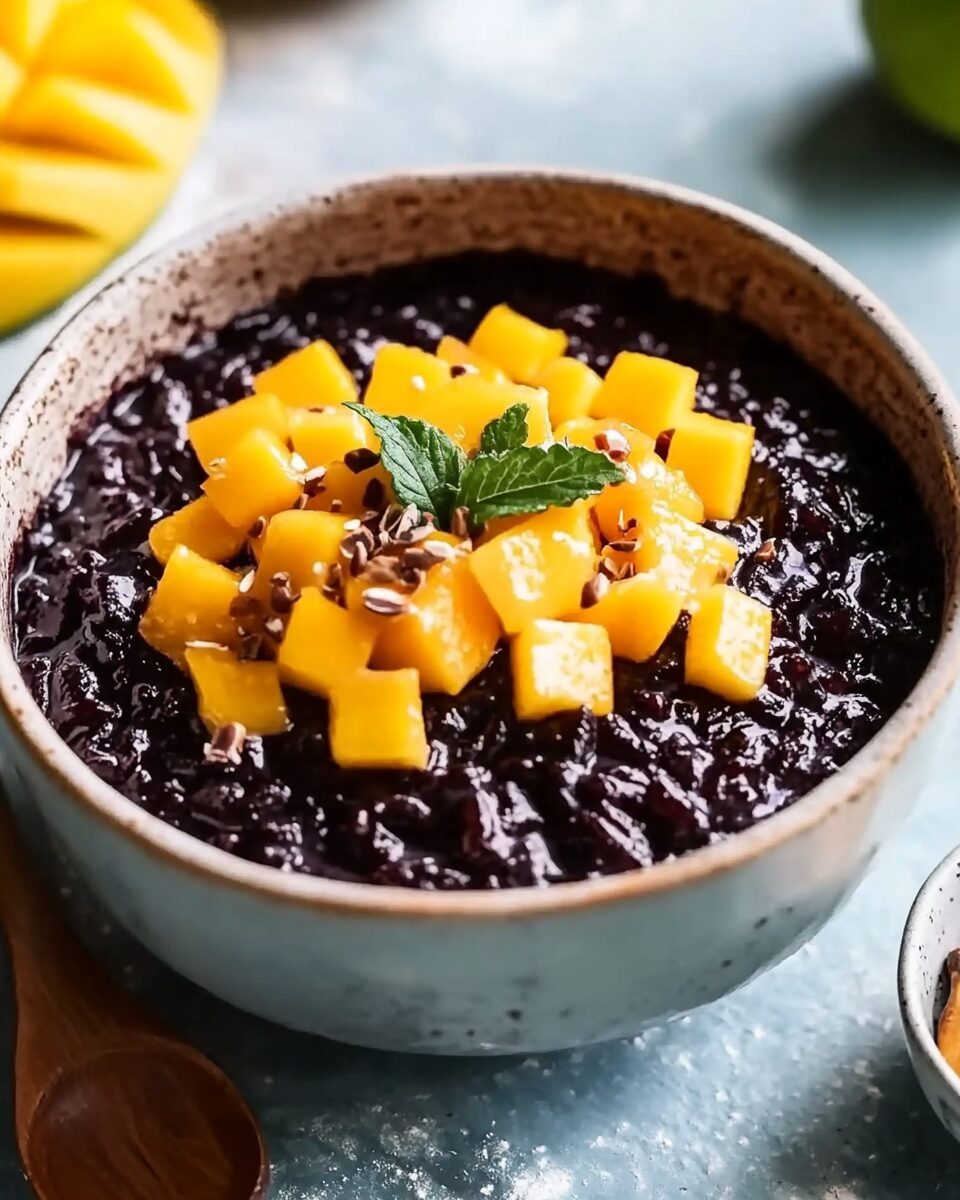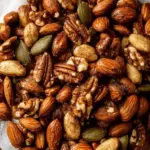This Thai Black Sticky Rice Pudding is a traditional Southeast Asian dessert that’s visually striking and full of nutty, caramel-like flavor. Made with black glutinous rice, water, and palm sugar, it’s naturally gluten-free, dairy-free, and vegan. Often served with coconut cream and tropical fruits like mango, this warm or chilled pudding is a perfect ending to a Thai-inspired meal—rich, creamy, and incredibly satisfying.
Full Recipe:
Ingredients
For the Pudding:
-
1 cup black glutinous rice (black sticky rice)
-
4 tbsp white glutinous rice (optional, for extra creaminess)
-
4 cups water
-
2 pandan leaves, tied into knots (optional)
-
1 cup loosely packed palm sugar (or dark brown sugar)
-
½ tsp salt
Toppings (Optional but recommended):
-
½ cup coconut cream
-
⅛ tsp salt (to mix with the coconut cream)
-
½ cup shaved coconut, toasted
-
Fresh mango cubes or crushed peanuts
Directions
-
Soak the Rice: Combine black and white sticky rice in a bowl. Add enough water to cover by 2 inches and soak for at least 4 hours or overnight.
-
Cook the Rice: Drain and rinse the soaked rice. Add to a pot with 4 cups of fresh water and the knotted pandan leaves. Bring to a boil, then simmer uncovered on low heat for 30 minutes. Stir frequently in the last 15 minutes to prevent sticking.
-
Add Sweetener: Once the rice is soft and the mixture has thickened to a creamy consistency, stir in the palm sugar and salt. Cook another 30 seconds until dissolved.
-
Check Consistency: The pudding should be thick and oozy like risotto—not runny or dry. Add a splash of water if too thick.
-
Serve: Ladle into bowls. Mix coconut cream with a pinch of salt and drizzle over the pudding. Garnish with toasted coconut and mango if using. Serve warm or chilled.
Nutrients (approximate per serving, serves 5–6)
-
Calories: ~290 kcal
-
Carbohydrates: ~55g
-
Protein: ~4g
-
Fat: ~6g
-
Sugar: ~22g
-
Fiber: ~2g
-
Sodium: ~140mg
What Makes Black Sticky Rice So Special?
Black sticky rice—also known as black glutinous rice or purple rice—is a unique grain prized in many Southeast Asian cultures for its texture, nutrition, and color. Despite its name, black sticky rice is not sweetened or processed like some Western rice products. Instead, its natural deep purple color develops during cooking and results from its high anthocyanin content—the same powerful antioxidant found in blueberries and purple cabbage.
When cooked, black sticky rice becomes wonderfully chewy and slightly sticky, with a hearty, nutty flavor that pairs beautifully with tropical ingredients. It provides a satisfying bite without being mushy and holds its texture well whether served warm or cold. In this pudding, a small amount of white glutinous rice is sometimes added to enhance creaminess, though it’s optional for purists who want to celebrate the black rice on its own.
A Heritage Rooted in Southeast Asian Cuisine
Black sticky rice pudding is enjoyed throughout Thailand, Laos, Cambodia, and parts of Indonesia and Vietnam, often made fresh at home or sold as street food in night markets. In Thailand, it’s frequently featured as a dessert at restaurants and family gatherings, particularly when paired with coconut cream and seasonal fruit like mango or durian.
The dish’s preparation is a labor of love—requiring a soak to soften the rice and careful simmering to coax out its full flavor and create a pudding-like consistency. But the payoff is a deeply satisfying dessert that honors traditional cooking techniques and time-tested flavor combinations.
Palm Sugar: Earthy Sweetness with Caramel Notes
The sweetness in Thai black sticky rice pudding comes primarily from palm sugar—a traditional Southeast Asian sweetener made from the sap of palm trees. Palm sugar has a rich, toffee-like flavor that’s less cloying than refined white sugar and pairs beautifully with the nuttiness of black rice. It melts easily into the warm rice, creating a luscious, caramel-colored glaze that deepens the pudding’s flavor and adds a slightly smoky depth.
For those who can’t access palm sugar, dark brown sugar or coconut sugar makes a fine substitute, though the flavor will vary slightly. These alternatives still offer the molasses-like notes needed to complement the rice and coconut.
Pandan Leaves: The Secret Aromatic Layer
While optional, pandan leaves are often tied into knots and simmered with the rice to infuse the pudding with a subtle, sweet fragrance reminiscent of vanilla and jasmine. Used widely across Southeast Asian cooking, pandan adds a layer of aroma and complexity that sets traditional versions apart. If pandan is unavailable, a small splash of vanilla extract can be used for a similar warming essence.
Pandan can be found fresh or frozen in Asian grocery stores. Simply wash and knot the leaves before adding them to the pot—they’re removed before serving but impart an unmistakable fragrance that enhances the overall experience.
Coconut Cream: A Creamy, Salty-Sweet Contrast
One of the most beloved features of Thai black sticky rice pudding is the drizzle of salted coconut cream served over the top. The richness of full-fat coconut cream adds silkiness, while a pinch of salt enhances the flavors of the rice and sugar, creating an addictive salty-sweet contrast.
Coconut cream, thicker than coconut milk, sits beautifully on top of the warm pudding or cold, gelled version, seeping into the cracks and crevices for added richness. You can adjust the salt to taste, but even a small amount is essential for balance. This final flourish is what gives the pudding a restaurant-quality finish and makes it feel indulgent and complete.
Toppings and Garnishes That Add Texture and Freshness
While the base of the pudding is more than enough to shine on its own, traditional and modern versions often include toppings that add texture, freshness, and beauty. Common garnishes include:
-
Toasted shaved coconut – Adds crunch and nutty depth.
-
Fresh mango cubes – Brings brightness and tropical sweetness.
-
Crushed peanuts or sesame seeds – Offer a satisfying contrast.
-
Banana slices or jackfruit – Local favorites in Thai kitchens.
-
Edible flowers or mint – For an elegant touch when serving guests.
These additions elevate the dish both visually and texturally, turning a humble rice pudding into a centerpiece-worthy dessert.
Perfect for Make-Ahead and Easy to Store
One of the most practical aspects of this dessert is how well it stores. Thai black sticky rice pudding keeps beautifully in the refrigerator for up to five days, making it an excellent make-ahead option. It can be served directly from the fridge or gently reheated in a saucepan with a splash of water to loosen the consistency.
This flexibility makes it perfect for weeknight dinners, potlucks, or any time you want a crowd-pleasing dessert without last-minute stress. If you’re making a big batch, you can even freeze portions in airtight containers—just thaw in the fridge overnight before serving.
Nutritional Benefits Beyond Dessert
While dessert isn’t usually considered health food, this pudding offers notable nutritional perks. Black sticky rice is high in fiber, iron, and antioxidants, thanks to its outer bran layer and dark pigment. It’s a whole grain, offering slow-digesting carbohydrates that can help keep you full and energized.
Coconut cream, when used in moderation, provides healthy fats that support brain health and satiety. Palm sugar has a lower glycemic index than white sugar and is rich in trace minerals, although it should still be enjoyed in moderation.
This makes Thai black sticky rice pudding a more nutrient-dense dessert option—especially when compared to cakes or custards filled with refined sugars and dairy. It’s satisfying without being overly rich, and its wholesome ingredients make it a natural choice for those seeking mindful indulgence.
Conclusion
Thai Black Sticky Rice Pudding is more than just a dessert—it’s a celebration of tradition, texture, and deep, comforting flavor. With its rich purple hue, chewy consistency, and caramelized sweetness from palm sugar, it offers a sensory experience that’s both exotic and familiar. Paired with a drizzle of salty coconut cream and the freshness of tropical fruit, it becomes a show-stopping dessert that’s surprisingly simple to prepare.
Whether you’re recreating a favorite dish from a Thai restaurant, introducing guests to a lesser-known Southeast Asian gem, or simply looking for a wholesome sweet treat that aligns with your dietary needs, this pudding is sure to impress. Naturally gluten-free, dairy-free, and vegan, it invites everyone to the table—and once you taste it, you’ll see why it’s been cherished for generations across cultures and cuisines.






